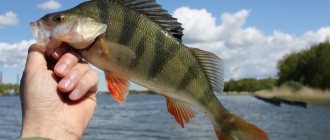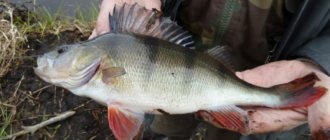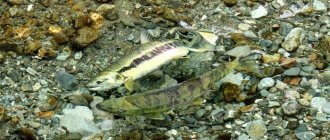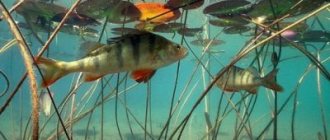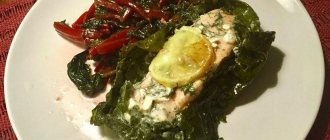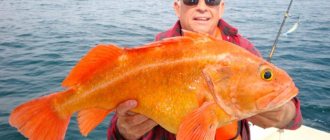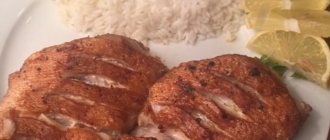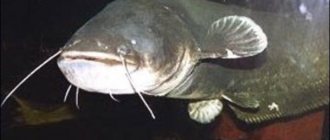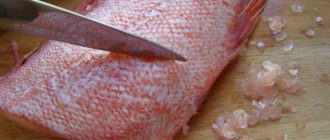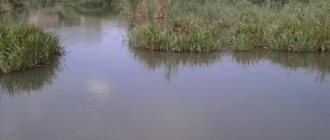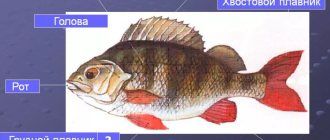Features of the annual cycle of perch
Spawning of perch as a type of reproduction is an obligatory period in the annual life cycle of perch. This is a special period for fish behavior. If the rest of the time the perch like to eat and, as a result, often swallows bait, then during the spawning period this fish is calm and cannot be attracted by anything.
Pre-spawning period
Shortly before the start of the spawning period, perch (deep and grass) are characterized by a pre-spawning glutton. At this time, they actively eat fry and eggs of white fish (small, medium size). For this purpose, perches follow the trail of accumulations of underbream, bleak, and roach.
At this moment, they are easy to catch using animal bait. This is used by both float fishing fans and spinning anglers. The pre-spawning period lasts approximately 7-9 days. Ends 2-3 days before spawning begins.
Post-spawning period
After spawning, the perch is weakened and strives to quickly replenish its strength. Consequently, the fish again begins to grab at any food. This is where you can give her various baits.
Experienced fans of fishing call the period after perch spawning the best time to catch it. The bite is the most intense when the fish are very hungry.
Range and seasonal habitats
Common perch is one of the most numerous species of fish found in Russian water bodies. It inhabits almost all rivers and lakes of the European part of the country.
This species is not found in the Amur and the rivers flowing into it. Perch is rarely found in mountain rivers, which are characterized by low water temperatures. Large schools of this predator are found in desalinated sea estuaries. Common perch can be found in reservoirs:
- New Zealand;
- Australia;
- Germany;
- Holland;
- Great Britain.
It has a large population in Northern Asia, as well as in some water bodies of African countries.
The habitats of perch can be different and directly depend on the time of year and the type of reservoir. In the spring, in large bodies of water, the “striped” can be found in shallow creeks and bays, where the water quickly warms up and where a large number of small fish come out to feed, which forms the basis of the predator’s diet. On small rivers in spring, the “striped” sticks to areas with depths of 0.3–1 m. At the end of April - May, a concentration of perch on a small river can be observed at the end of the rifts, not far from the coastal zone.
In the summer, perch likes to stand in the shade of the leaves of water capsules.As the water warms, perch moves to areas with depths of 2–3 m, but can often go into shallow water in search of food. On large lakes and reservoirs, perch in the summer should be looked for in shallow water “banks”, which can be located at a considerable distance from the shore.
Important! Small grass perch remains in the coastal zone throughout the year and rarely goes to a depth of more than 1.5 m. The predator’s favorite summer stopping places on the river are:
The predator’s favorite summer stopping places on the river are:
- coastal pools;
- areas behind large boulders or trees that have fallen into the water;
- places where the remains of old buildings are located at the bottom;
- boat docks;
- areas with reverse flow.
As the water gets colder, the “striped one” begins to actively migrate through the reservoir in search of accumulations of juvenile fish. At this time, it can rarely be found at a depth of less than 3 m. On small rivers, the predator occupies the deepest areas and enters shallow water only on windless, sunny days, when the fry are basking in the shallows.
At the very beginning of winter, immediately after ice sets in, the “striped one” prefers to hunt at a depth of 2–3 m. As the ice shell grows, it moves to areas with depths of 5–7 m, where it continues to remain until it goes under the ice spring melt water. In winter, on small rivers, perch stands in deep coastal pools and near streams flowing into the reservoir.
Beginning of perch spawning
To start spawning any fish, certain conditions must be met. When a perch goes to spawn can be determined by the coincidence of the following natural factors:
- Temperature indicators of air and water. Fish of this breed begin to spawn when the water temperature in the reservoir rises to plus 8 degrees Celsius. In some cases, the fish prefers to wait for an increase to 9-11 degrees. For fishermen, this means that as soon as the water temperature reaches these levels in the spring, you can expect some lull in the bite.
- In addition to the temperature factor, the saturation of water with oxygen is important. Consequently, after winter the ice should disappear from the reservoir.
For perch to begin spawning, both of these conditions are mandatory. Fish will not spawn either in cold water or without oxygen.
Where do perch spawn?
The location of perch spawning depends on the subspecies of fish. Deep-sea perch does not like to go into shallow water and spends the spawning period at a depth of 150 cm or more. Its grass counterpart chooses a depth of 50 to 100 cm. Often such places become meadows and clearings flooded by rivers in the spring.
In addition to depth, all perches have other requirements for a spawning site:
- Minimal flow, or better yet, no flow at all.
- Acceptable oxygen balance for perch.
- The presence of vegetation at the spawning site: flooded trees, old reeds, stones, water lily rhizomes.
The place should be just such that the eggs do not die later.
Perch spawn for about three weeks, starting at sunrise and gradually decreasing activity towards midday. At this time, the fish acquires a bright color.
Varieties
As already mentioned, there are more than 200 varieties of perch. Each has its own individual qualities.
River
The most common species has greenish-yellow scales. The head and mouth are large. The most common catch of fishermen. It lives in fresh water reservoirs, where it is introduced specifically for breeding.
It differs from the river one in a lighter or, conversely, darker color, and in greater weight, which reaches 5 kg.
It is distinguished by its low weight - only 70. The body shape is more elongated. The predator lives in shallow water near algae.
Deep
It lives at a depth of more than 10 m in freshwater bodies. It is a coveted trophy among fishermen; they often go underwater fishing for this specimen.
The deep predator is divided into subspecies:
coastal
found at a depth of 7-8 m. Externally different from the common perch with smaller eyes;
deep
a real fisherman's dream. Individuals reach 50 cm and 4 kg. They live at a depth of more than 10 m. They differ from their relatives in their bluish color, powerful body, and strong teeth.
The growth rate of the underwater predator comes from the cleanliness of the reservoir - in unpolluted water the fish develops almost twice as fast. In addition, perch is vulnerable to temperature changes - at lower temperatures, activity decreases.
Yellow
Average length 33 cm, weight – 1.5 kg. Females of this species are larger than males. They live in freshwater bodies of water.
They differ from the common perch in having a more elongated, flattened body. The color of the back is dark green, the belly is white-yellow, the sides are golden-green with characteristic black stripes. The fins of the fish are reddish with gold edging. The saturation of shades depends on the habitat and purity of the water.
Perch firebrand
The official name is rotan. Externally similar to a bull. Color varies from gray-green to black with stripes or spots. The dark color usually appears during the mating season.
It lives in fresh waters, the quality of which is not important, since firebrands are very unpretentious. The length reaches 25 cm. The maximum lifespan is 7 years. The diet of rotan is leeches, small fish, larvae.
Balkhash
Maximum length – 50 cm, weight – 2 kg. Found in lakes. It is distinguished by silvery scales, an oblong shape, and an elongated lower jaw. It feeds on other fish and does not disdain its own brood in the absence of other food.
The meat of the Balkhash predator is considered the most delicious of the entire species.
Solar
A bright, beautiful representative of his species. It is distinguished by blue-gold scales and white and cream stripes, resembling rays, on the head. The color of males is more saturated than the color of females. The body is round, elongated with smooth features. There are small fins-ears near the head. Average length – 35 cm.
Found in fresh waters. Sun perches are often kept at home, placed in an aquarium for their attractive appearance.
Nautical
Despite the name, sea bass belongs to a different family and species. Its appearance and habits are strikingly different from its river counterpart, and its lifespan exceeds a hundred years.
Read Salmon and salmon, what is the difference?
The main difference is that its body has poisonous spines that do not harm humans, but are dangerous to other inhabitants of the underwater world. Saltwater perches typically measure up to 50 cm in size and have a maximum recorded weight of 10 kg.
Externally, the marine predator is distinguished by a large head, large eyes, and spines. The color is predominantly red with pinkish hues. The belly is light, the back is brown. The color varies slightly depending on the subspecies.
Nilsky
It is deservedly considered the fisherman’s most desired prey, because its weight reaches 200 kg and its length is 2 m. However, hunting for a giant is exhausting - often the fish pulls out the fishing rod and breaks the fishing line. Therefore, before fishing, you should gain experience, and also take a camera with you - a photo of the caught perch will become a pleasant memory.
The Nile perch is considered one of the largest freshwater predators that dominates inhabited water bodies. Externally, the huge predator is similar to a pike perch. The head is flattened, the eyes are large black and yellow. The shade of the scales is mainly silver or bluish, but there are individuals with a greenish-yellow color.
The diet includes crustaceans, small fish, and insects. Some experts claim that the Nile representative is not averse to eating drowned people, but does not specifically hunt for humans.
Geography of perch spawning
Average information about perch spawning, when it begins and ends in the regions of Russia:
- Astrakhan region - from mid-April to May.
- Rostov region, Krasnodar region - often starts in March.
- Moscow region, Leningrad region - from late April to mid-May.
- Central Russia - spawning occurs in May.
- Ural - from late May to mid-June.
In the Astrakhan region, at the fishing base “Sazanya Bay” you can hunt plenty of perch. It actively bites here almost all year round. Having received a rich catch, you can cook this striped predator right here.
TAGS:
What does perch eat and when does it feed?
Large perch is a very agile, strong and predatory fish. One can be amazed at the greed and tenacity with which this predator pursues its prey. The fish jumps out of the water like crazy, and the striped one chases after it, opening its huge mouth with a loud slurping sound until it grabs it. During the feast, the chomping sound of this large predator is so loud that in calm weather it can be heard a hundred meters away. Small perch are not inferior to large ones in agility and agility, hunting for prey while feeding. Probably, when catching perch with a spinning rod, every fisherman has seen how schools of perch hunt for fry; it even happens that, carried away by the pursuit, they jump out after their prey onto the shallows and onto the coastal sand.
The striped predator is active and seeks food almost all year round, except for the period of deep winter. During the year there are the brightest periods when the perch is hungry and actively feeds. Usually there are periods of zhora in the spring before spawning in March on the last ice, and in the spring after spawning the zhor comes again. Perch also gets hungry in the fall from the second half of September until the weather gets colder. And when the water becomes cold, predators go to deeper places.
And after the freeze-up, on the first ice, fattening perch is actively caught with winter gear and you can catch more of it than in summer. In the summer there are outbreaks of perch zhor, when the weather changes and after the sultry heat there is a cold snap. Among fishermen, the moments when a perch is hungry in open water are usually called the perch cauldron, when even from a distance one can see as if the water is boiling from the powerful movement of a school of predators chasing the fry in the upper layers of the water.
The perch fish feeds on everything, from small aquatic insects to fairly large fish, as long as it is within its strength and can fit into its wide mouth. The striped predator itself is rarely eaten by other predatory fish, since they do not like its sharp dorsal spines in its fins. The main food of perches is small fish, as well as the eggs of other fish. Large individuals love to feed on crayfish during their molting, and therefore stay near stones, snags, under the shore, near crayfish burrows. Small crustaceans are found in many lakes in northern and central Russia, and constitute a tasty food for perciformes.
Read DIY boat motor
Tags
Carp Buffalo Spring Vobla Asp Winter Crucian Rudd Summer Fishing baits Lower Volga Perch Autumn Fisherman's reminder Lures Bite forecast Fishing in Astrakhan Fishing baits Fishing tackle Fishing secrets Catfish Fishing methods Pike perch Catch Pike
